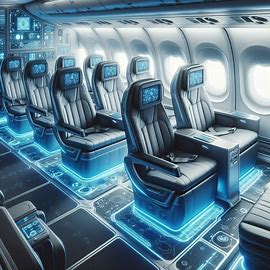
Introduction
As passenger expectations continue to evolve and technology advances, the commercial aviation industry is experiencing a transformative shift in seating design and configuration. From luxurious first-class pods to innovative economy layouts, the commercial aircraft seating trends in 2025 reflect a new era focused on comfort, efficiency, sustainability, and personalization. This article explores the latest developments reshaping how airlines design their cabins for profitability and passenger satisfaction.
1. Evolution of Cabin Classes
The traditional three-class layout—economy, business, and first class—is being reimagined to reflect changing passenger demographics and demand.
a. Rise of Premium Economy
Premium economy has become a profitable middle ground between economy and business class.
- Wider seats, more legroom, and enhanced meal service distinguish premium economy.
- Airlines like Lufthansa and Singapore Airlines have invested heavily in this class.
- Premium economy attracts both cost-conscious business travelers and leisure travelers seeking extra comfort.
By 2025, many airlines have reallocated cabin space to increase the number of premium economy seats.
b. Decline and Redefinition of First Class
First class is being phased out on many routes in favor of more versatile and cost-effective seating options.
- Airlines prefer high-margin business class suites over expansive first-class cabins.
- Where it remains, first class has evolved into ultra-luxury pods with sliding doors, personal wardrobes, and private screens.
- Examples include Emirates’ “Game Changer” suite and Singapore Airlines’ private rooms.
The new first-class trend is less about quantity and more about exclusivity.
2. Technological Innovations in Seating
Seating design is leveraging the latest technologies to enhance passenger experience and operational efficiency.
a. Smart Seats and Personalization
Smart seat technology integrates electronics to provide tailored in-flight experiences.
- Embedded sensors monitor posture and movement to adjust lumbar support.
- Passengers can control lighting, climate, and entertainment via mobile apps or seat interfaces.
- Airlines are exploring biometric seat access and customized seat settings for returning passengers.
These innovations align with the industry’s broader move toward personalized flying experiences.
b. Lightweight and Modular Designs
Reducing aircraft weight is a critical cost-saving and environmental goal.
- Seats made from carbon fiber and advanced composites are now standard.
- Modular designs allow easier maintenance and reconfiguration between classes.
- Some models enable rapid switching between premium and economy layouts.
| Feature | Benefit |
|---|---|
| Lightweight frames | Reduces fuel burn |
| Modular components | Faster turnaround time |
| Replaceable upholstery | Hygiene and branding flexibility |
Technology is enhancing not just comfort but also airline profitability.
3. Economy Class Redefined
Far from being neglected, economy class is undergoing significant improvements to balance comfort with high-density layouts.
a. Slimmer Yet More Comfortable Seats
New materials and ergonomic advances are enabling thinner seats without sacrificing comfort.
- Recline-free designs reduce seat pitch disputes while preserving legroom.
- Memory foam cushions and adjustable headrests enhance comfort.
- Airlines like Air New Zealand and ANA are leading in ergonomic seat innovations.
Comfort improvements help boost customer satisfaction without reducing seat count.
b. Innovative Layouts and Configurations
To improve passenger experience and boarding efficiency, airlines are testing novel seating formats.
- “Staggered” seating improves privacy even in economy.
- “Flex seating” zones allow groups or families to face each other.
- Air New Zealand’s SkyNest introduces bunk-bed style sleeping pods in economy.
These ideas reflect an evolving understanding of passenger needs on long-haul flights.
4. Sustainability and Materials
Sustainable design is no longer optional; it’s a core part of aircraft seating trends.
a. Eco-Friendly Materials
Airlines and manufacturers are prioritizing seats made from recycled and sustainable sources.
- Recycled aluminum frames and biodegradable plastics are gaining traction.
- Natural fiber composites and vegan leather reduce environmental impact.
- Lightweight designs help reduce carbon emissions by lowering aircraft weight.
This aligns with broader aviation goals for net-zero carbon emissions by 2050.
b. Lifecycle and Reusability
Seats are being designed with disassembly and recycling in mind.
- Modular parts are easier to replace or refurbish.
- End-of-life seats are now easier to repurpose or recycle.
- Airlines are tracking lifecycle emissions from production to disposal.
By 2025, sustainable seating has become a key part of airlines’ ESG strategies.
5. Enhanced Passenger Experience
Passenger comfort and well-being remain central to seating innovation.
a. Wellness and Ergonomics
Ergonomic design is crucial for passenger health, especially on long-haul routes.
- Lumbar support, adjustable footrests, and headrests reduce fatigue.
- Seats now include wellness alerts reminding passengers to stretch or hydrate.
- Enhanced cabin pressurization and quieter seating zones improve rest quality.
Passenger wellness is now a priority across all cabin classes.
b. Connectivity and Entertainment
Passengers expect robust in-flight entertainment and connectivity.
- In-seat charging and wireless charging pads are standard.
- Personal device pairing allows seamless media streaming.
- Seatback screens feature 4K resolution and intuitive touch controls.
This integration makes the seat not just a place to sit, but a personalized hub for work and entertainment.
Conclusion: Shaping the Future of Air Travel
The commercial aircraft seating trends in 2025 showcase an industry focused on delivering tailored, sustainable, and high-value experiences for passengers. Innovations in design, materials, and technology are transforming seats into smart, adaptive, and environmentally friendly spaces.
As airlines continue to compete on passenger comfort and brand identity, we can expect even more dramatic changes in the years ahead.